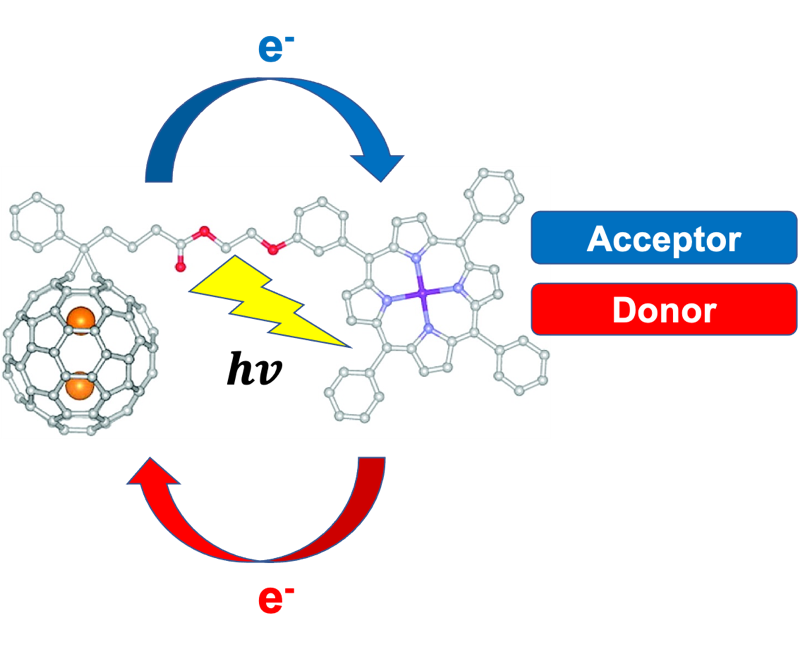RESEARCH PROGRAMMES
P1: Organic Nanosystems for Light Harvesting and Energy Conversion
RESEARCH SUPERVISOR
Prof Wojciech Gawelda
Research Group website: http://www.imdeananociencia.org/home-en/people/item/wojciech-gawelda/
Prof Nazario Martín León
Research Group website: https://www.nanociencia.imdea.org/index.php/home-en/people/item/nazario-martin-leon
RESEARCH TOPIC DESCRIPTION
This project will apply various complementary ultrafast X-ray and optical spectroscopic techniques to probe in “real-time” the elementary steps governing the reactivity and efficiency of electron transfer (ET) processes in functional organic nanosystems designed for solar energy conversion.
The main goal of the experimental studies will be the application of the emerging X-ray free electron lasers (XFELs) to extract a mechanistic and site-selective (with atomic specificity) description of the ultrafast dynamics (both electronic and structural), which will allow further optimization of their reactivity and efficiency towards photovoltaic applications.
For this purpose, we will apply a combination of femtosecond X-ray absorption (fs-XAS) and emission (fs-XES) spectroscopies, together with X-ray solution scattering techniques (fs-XSS), to investigate mixed inorganic-organic dyads consisting of a metalloporphyrin (MP) linked rigidly with a bridge ligand to an endohedral fullerene (EF). Our interest will focus on the photoinduced intra- and intermolecular ET dynamics, and we contemplate the possibility of using metallofullerenes to study the dynamical processes of charging and stability of cationic and anionic EF isomers. Furthermore, we propose to use density functional theory (DFT) methods specially designed to describe large systems, such as self-consistent charge density functional tight-binding (SCC-DFTB), which has been successfully used in previous work on EFs. The theoretical results will also serve as a feedback for knowledge-based chemical synthesis and further spectroscopic characterization.
The proposed research has a very interdisciplinary character and will be carried out in a close synergy between experimental groups (Supervisor 1 and 2) and theoretical modeling group (Supervisor 3) to allow for tailored chemical synthesis of novel porphyrin-fullerene dyads provided with the feedback from both the advanced spectroscopic techniques and theory.
POSITION DESCRIPTION
A typical background would be in Chemical Physics, Physical Chemistry (or any related fields) with a background in physical chemistry or molecular physics, with special emphasis on experimental expertise in ultrafast optical and/or X-ray techniques. The typical profile would be one capable of independent and autonomous work, but also a good team player, due to a collaborative nature of the proposed research.
The fellow will have an opportunity to broaden their experimental skills by training in advanced X-ray techniques using the world’s most intense and modern pulses X-ray sources, such as the XFELs. These will be complemented by studies on longer timescales at 4th generation synchrotrons and further characterization in UV-VIS-NIR range using laboratory-based laser techniques (femtosecond transient absorption and emission spectroscopies, etc.).
Due to the interdisciplinary character of proposal, the fellow will have ample opportunities to broaden their skills and experience in other experimental and theoretical fields, such as advanced DFT modelling and chemical synthesis and interact with world-leading experts in their respective fields of research. The proposed project foresees several Secondment Options, targeting large-scale research facilities such as ALBA synchrotron (Barcelona, Spain) and European XFEL (Schenefeld, Germany), as vital ingredients of the experimental work to be carried out. It is expected that the candidate will pursue short-term stays at Partner Organization during the fellowship.
PARTNER ORGANIZATIONS
The proposed research requires the application of advanced X-ray technique using large-scale research infrastructures, such as synchrotrons and X-ray free electron lasers. We foresee close collaboration with both ALBA synchrotron and European XFEL facility. The involvement of these Partner Organizations is crucial for the success of the fellowship providing the unique tools. for carrying our advanced X-ray characterization of newly synthesized dyads in both steady-state and time-resolved regimes.

